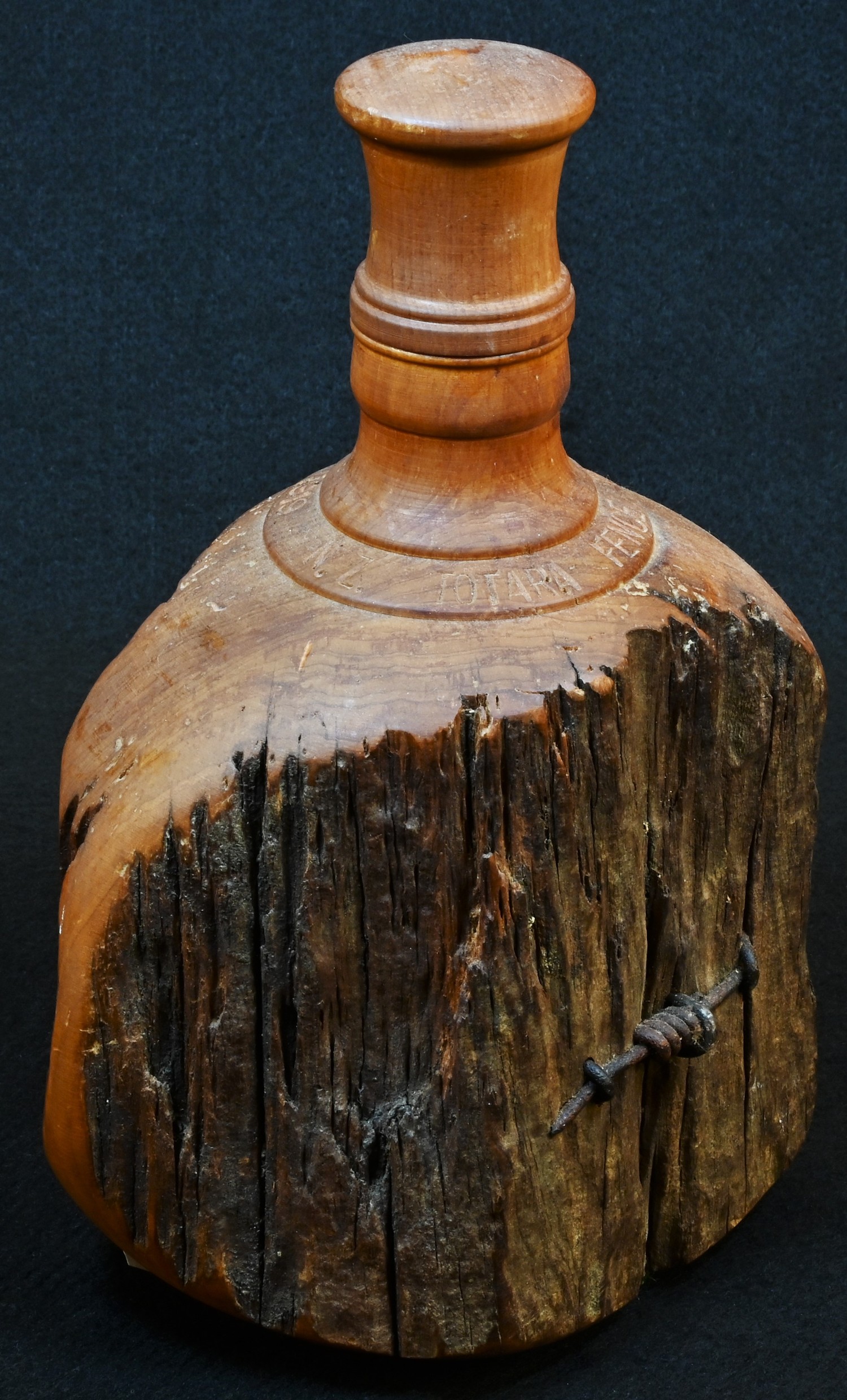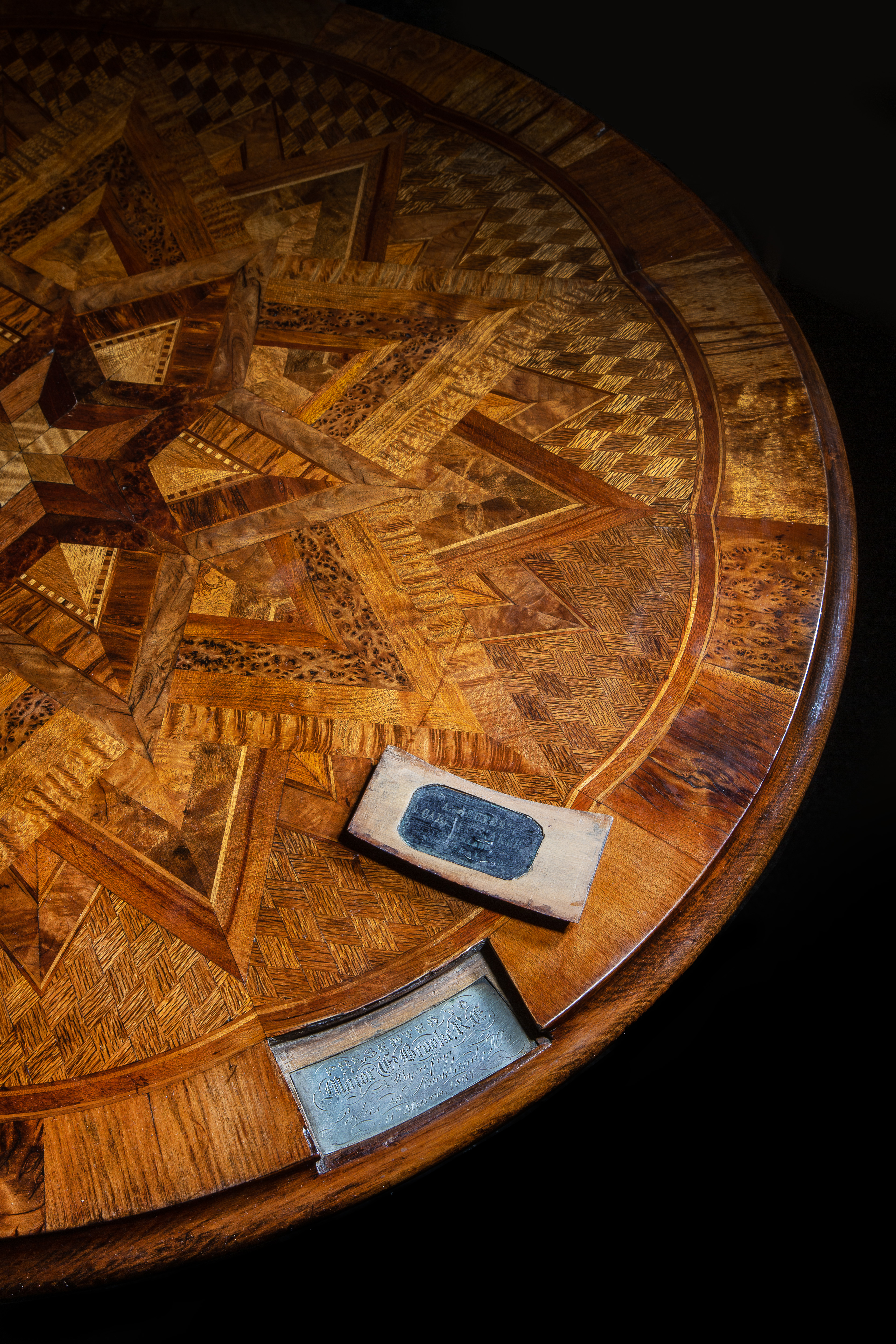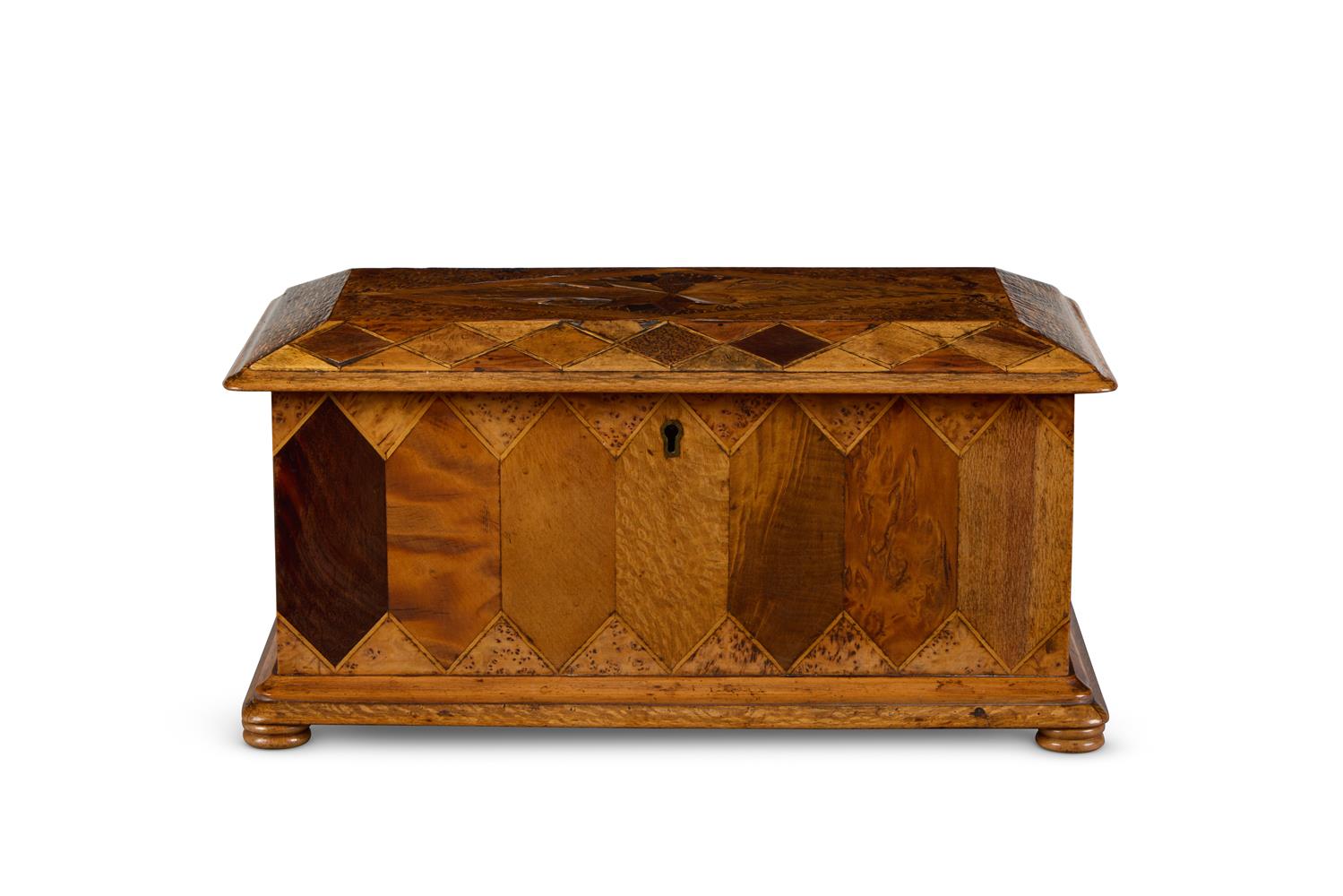A New Zealand Totara Knot and Hinan wood occasional table, by Johan Marti Levien, second quarter 19th century, the rounded rectangular tilt-top above a faceted baluster support with a foliate carved collar, on a concave-sided platform with scroll feet and castors, 71cm high, 61cm wide 48cm deep, the top of the block bearing a manuscript label 'this wood imported from Wellington - New Zealand - the native names are Totara with Hinan border and manufactured G.D.M Levene, New Zealand House, New Broad St .... London Johan Martin Levien (1811-1871) was born in Barth, a sea-port in Western Pomerania, Prussia where he undertook his cabinet-making apprenticeship, becoming a Master in 1831. He followed this with an extensive period of travel, visiting Norway, Denmark, Sweden, Russia and Hamburg. During his time in Europe he was not only able apply refine his skills but he also attended various schools of drawing and design prior to setting sail for Pernambuco in Brazil in 1837 to set up his own business. Unfortunately the climate did not suit his health, causing him to leave for Rio de Janeiro c. 1840. Here Levien devoted himself to sourcing exotic timber specimens amongst the interior forests. His appetite for collecting rare wood samples lead him to Wellington, New Zealand later the same year where he believed unknown timbers awaited his discovery. These were very early days for settlers which necessitated Levien building his own house with the assistance of local Maoris - a primitive rush construction secured by poles in ground. Once settled he began exploring the hinterland forests to identify suitable cabinet timbers, drawing on the experience he had gained in Brazil. Here he selected a range of native timbers including Hinau, Kauri, Mai, Matai, Rata, Rimu and Totara. This was heavy work as the newly hewn trees had to be carried back through the forest to the base camp before they could be sawn into planks. Some of the trees were over a hundred feet tall with boughs up to twelve feet in diameter. When Levien arrived in Wellington he could neither speak English or Maori but quickly assimilated both languages and built up a rapport with the native tribesmen. He built a beachside store and workshop on what is now known as Lambton Quay and shortly after married an English woman of high social standing. By 1843 he had built a flourishing business as a contemporary report recorded: 'Mr Levien...has been industriously employed in proving the value of our forests, by working native woods in all descriptions of furniture. His work is beautifully executed, and his prices moderate'. The report went on to state 'We are glad to find a considerable quantity of furniture wood being shipped by all the vessels now proceeding from this port to England. Mr Levien...proceeds in the brig Victoria to London, with a view of establishing a warehouse for the manufacture and sale of New Zealand wood ...Mr Levien takes with him a large quantity of choice specimens of our woods, carefully selected by himself, and well seasoned before embarked...'.However Levien was never to return to New Zealand, possibly for a combination of reasons including the unrest in that country arising over land rights and his rapid establishment of a business premises in London. This was located at the New Zealand Company, Broad Street and a letter from London, dated 17 October 1844 testifies to his success. It noted that 'Levien has an order from the Baron of Rothschild to fit up an entire room with totara and hinau; old Mr.Rothschild is about to do the same thing, and Gillow, Doubiggen, and some others of the cabinet-makers have purchased good quantities of his woods'. On 5 August 1846, Levien received a Royal Appointment, recorded in London Sun of 22 August under the heading MR. LEVIEN. HIS SPLENDID WORKMANSHIP FOR THE QUEEN, AND THE FURNITURE WOODS FROM NEW ZEALAND: 'We are happy to announce that her Majesty has been pleased to confer upon Mr Levien the appointment of cabinet-m
A New Zealand Totara Knot and Hinan wood occasional table, by Johan Marti Levien, second quarter 19th century, the rounded rectangular tilt-top above a faceted baluster support with a foliate carved collar, on a concave-sided platform with scroll feet and castors, 71cm high, 61cm wide 48cm deep, the top of the block bearing a manuscript label 'this wood imported from Wellington - New Zealand - the native names are Totara with Hinan border and manufactured G.D.M Levene, New Zealand House, New Broad St .... London Johan Martin Levien (1811-1871) was born in Barth, a sea-port in Western Pomerania, Prussia where he undertook his cabinet-making apprenticeship, becoming a Master in 1831. He followed this with an extensive period of travel, visiting Norway, Denmark, Sweden, Russia and Hamburg. During his time in Europe he was not only able apply refine his skills but he also attended various schools of drawing and design prior to setting sail for Pernambuco in Brazil in 1837 to set up his own business. Unfortunately the climate did not suit his health, causing him to leave for Rio de Janeiro c. 1840. Here Levien devoted himself to sourcing exotic timber specimens amongst the interior forests. His appetite for collecting rare wood samples lead him to Wellington, New Zealand later the same year where he believed unknown timbers awaited his discovery. These were very early days for settlers which necessitated Levien building his own house with the assistance of local Maoris - a primitive rush construction secured by poles in ground. Once settled he began exploring the hinterland forests to identify suitable cabinet timbers, drawing on the experience he had gained in Brazil. Here he selected a range of native timbers including Hinau, Kauri, Mai, Matai, Rata, Rimu and Totara. This was heavy work as the newly hewn trees had to be carried back through the forest to the base camp before they could be sawn into planks. Some of the trees were over a hundred feet tall with boughs up to twelve feet in diameter. When Levien arrived in Wellington he could neither speak English or Maori but quickly assimilated both languages and built up a rapport with the native tribesmen. He built a beachside store and workshop on what is now known as Lambton Quay and shortly after married an English woman of high social standing. By 1843 he had built a flourishing business as a contemporary report recorded: 'Mr Levien...has been industriously employed in proving the value of our forests, by working native woods in all descriptions of furniture. His work is beautifully executed, and his prices moderate'. The report went on to state 'We are glad to find a considerable quantity of furniture wood being shipped by all the vessels now proceeding from this port to England. Mr Levien...proceeds in the brig Victoria to London, with a view of establishing a warehouse for the manufacture and sale of New Zealand wood ...Mr Levien takes with him a large quantity of choice specimens of our woods, carefully selected by himself, and well seasoned before embarked...'.However Levien was never to return to New Zealand, possibly for a combination of reasons including the unrest in that country arising over land rights and his rapid establishment of a business premises in London. This was located at the New Zealand Company, Broad Street and a letter from London, dated 17 October 1844 testifies to his success. It noted that 'Levien has an order from the Baron of Rothschild to fit up an entire room with totara and hinau; old Mr.Rothschild is about to do the same thing, and Gillow, Doubiggen, and some others of the cabinet-makers have purchased good quantities of his woods'. On 5 August 1846, Levien received a Royal Appointment, recorded in London Sun of 22 August under the heading MR. LEVIEN. HIS SPLENDID WORKMANSHIP FOR THE QUEEN, AND THE FURNITURE WOODS FROM NEW ZEALAND: 'We are happy to announce that her Majesty has been pleased to confer upon Mr Levien the appointment of cabinet-m





.jpg?w=400)









Testen Sie LotSearch und seine Premium-Features 7 Tage - ohne Kosten!
Lassen Sie sich automatisch über neue Objekte in kommenden Auktionen benachrichtigen.
Suchauftrag anlegen